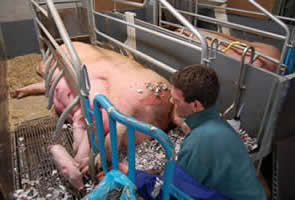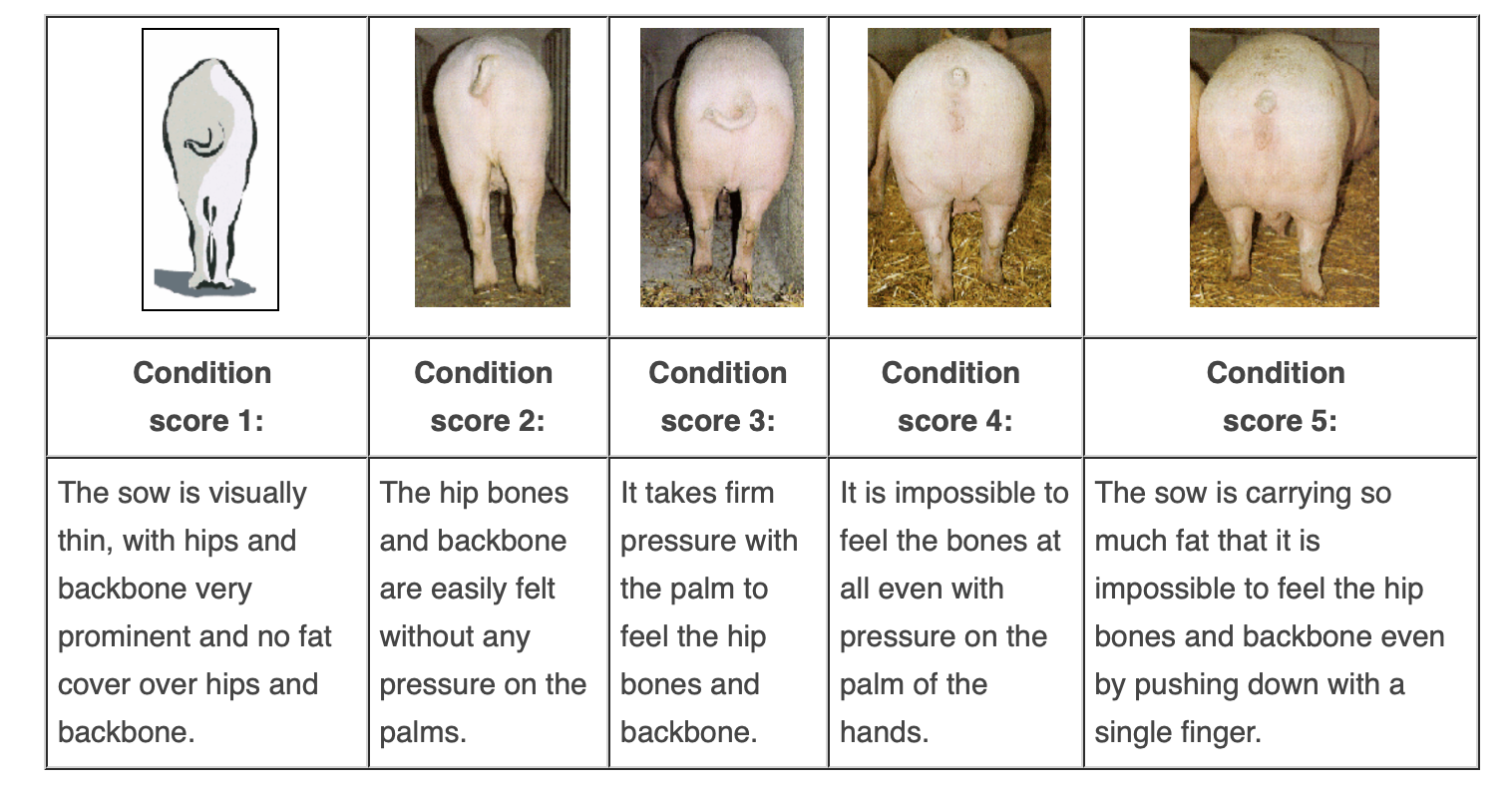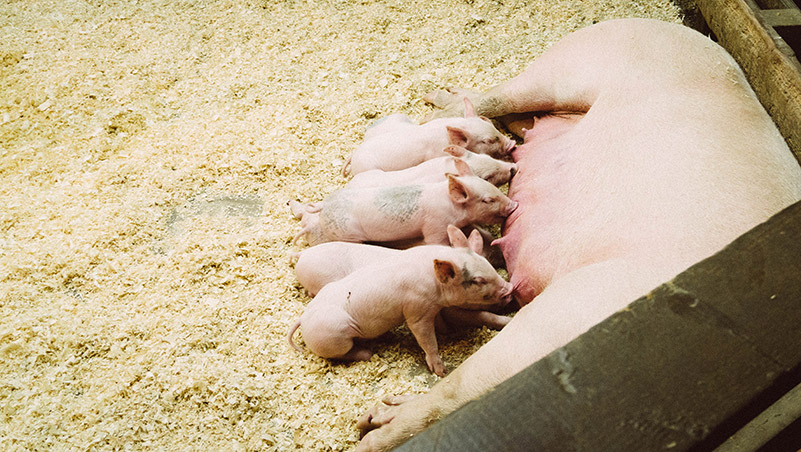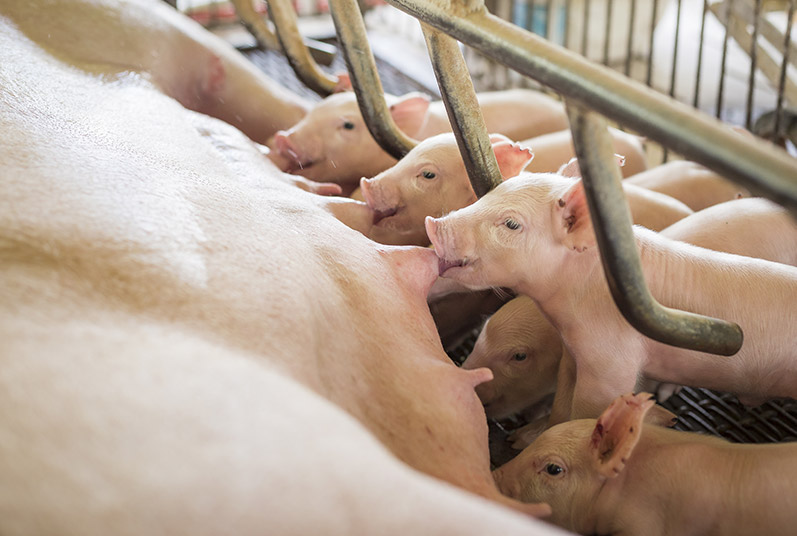Piglet Management
Page 07 /
In major pig producing countries, 7-8% of piglets are stillborn and 11-13% of piglets die in the preweaning period. In order to reduce these levels, management is imperative, especially early in life as most of the deaths occur around farrowing and during the first few days of life.
In this FAAST Review we will discuss:
- Sow management prior to farrowing
- Management during farrowing
- Preventing hypothermia
- Colostrum intake
- Hygiene
- Prevention of crushing
Sow Management Prior to Farrowing
Similar to other species, management of the sow prior to giving birth is important to reduce the chances of stillborn piglets and improve the viability and vitality of neonatal piglets.
Body Condition
Body condition at farrowing is an important predictor of duration of farrowing and stillborn piglets; ideally, sows should have a body condition score of 3-3.5, with 80% having a score of 3. This is because over conditioned sows have more fat layers in and around the birth canal, which reduces its diameter and creates an obstacle for piglets attempting to pass through at birth.
Pre-farrowing diets that lead to constipation can also create longer durations of farrowing due to a hard feces creating a physical obstacle during birth1.
Work with your nutritionist to determine the optimal body condition score prior to farrowing and to determine the correct diet to feed to your sows
Farrowing Environment
The environment that the sow is housed in prior to farrowing can also predict farrowing duration and difficulty.
Space
The process of giving birth may be easier if sows are allowed to freely move and turn around. If sows are being moved from loose housing to crates, it is important to allow 3-5 days of transition time prior to farrowing. Movement to farrowing crates is stressful for sows, which can impact the farrowing process. This transition time allows the sow time to adjust to her new housing prior to farrowing, another stressful period for sows.
Bedding
Providing bedding material to permit nest-building behaviour before farrowing may also have a positive effect on reducing farrowing duration and stillbirth rate as it may reduce stress. This may be difficult in slatted floor barns, but more research is being done in this area.
Temperature
Sow temperature in late gestation is also a risk factor for stillbirth. Sows that experienced severe heat stress (> 38°C) in late gestation had a significantly higher stillbirth rate. Maintaining temperatures in farrowing housing below 29°C in late gestation or cooling sows in hot weather is recommended2.

Source: ACKO Funki
Farrowing Management
Keeping a close eye during the farrowing process is key, as this is at a time when the risk of piglet mortality is highest.
Monitoring
When first examining the sow vaginally, it is important to ensure that the vulva of the sow is cleaned with soap, clean gloves are used, and an adequate amount of lubrication is used to prevent injury or infection of the sow. When examining the birth canal, check for a fetus to see if it needs to be repositioned, or determine if the birth canal is obstructed. If the birth canal is not obstructed it may be possible to administer oxytocin to stimulate uterine contractions.
When to Intervene?
It is recommended that an intervention is considered if the interval between piglets exceeds 30-60 minutes, or if the sow has not expelled any piglets but appears distressed, depressed, or weak, or is showing an abnormal vaginal discharge.

Source: Rattlerow Farms
Work with your veterinarian to ensure that you develop a protocol that highlights when an intervention should be applied and what needs to be done depending on the situation encountered
Preventing Hypothermia
Hypothermia can be one of the major causes of mortality for newborn piglets. The farrowing room is often at a temperature below the critical limit of newborn piglets, meaning they must use their energy reserves to stay warm. As these energy stores are limited, it is critical to ensure early intake of colostrum (discussed below) and provide supplemental heat.
Keeping Them Warm
To meet the needs of the piglet, a heat lamp, heat mat, or in-floor heating can be provided after birth and in the first week of life to minimize heat loss and prevent hypothermia. Supplemental heat sources should provide heat to piglets up to 34°C to prevent cold stress. In fact, placing piglets under a heat lamp immediately after birth has been found to decrease newborn piglet mortality by 50% or more3. Helping piglets to maintain their body temperature will also ensure that they continue to suckle, as cold pigs tend to nurse less and have reduced digestion.

Source: The Academic Abbatoir
Drying piglets with straw, paper towels, or other materials has been shown to increase body temperature and get piglets to suckle faster following birth. Other methods to prevent heat loss is to ensure that drafts do not occur by reducing air movement, keeping a high ambient air temperature, and ensuring the floor adjacent to the udder and creep area is well insulated or bedded.
Colostrum Intake
Colostrum intake by neonatal piglets is essential. Colostrum is the sole external source of energy in early life, and contains nutrients and other components that can promote intestinal development. In addition, insufficient intake of colostrum is a major cause of mortality due to the increased risk of disease. This is why it is essential to ensure early and adequate colostrum intake occurs to stimulate immune function and protection.
For more information on colostrum intake for piglets, be sure to read the Host Immunity section of the Antimicrobial Stewardship in the Ontario Swine Industry FAAST Review.
How Much is Enough?
It is estimated that piglets need a minimum of 160 g/kg of birth weight of colostrum to have successful passive transfer, thus working with the piglet to attach to the sow’s teats to suckle the colostrum is important4. Safe and easy access to the udder is a must, so having a sow that is passive and lies in a lateral position to expose her udder is critical. Excellent farrowing management and methods to prevent hypothermia will help generate a piglet that has vitality and will suckle well with minimal assistance.
Hygiene
Measures to reduce the challenge of viruses and bacteria at the piglet level is important. Batch farrowing where all-in, all-out management can be achieved is a recommended method to reduce disease burden. This management practice will allow for all the pens in farrowing housing to be cleaned, disinfected, and dried thoroughly between groups.
During the suckling period, it is also important to keep the floors dry and clean. Good drainage and frequent removal of manure or dirty bedding (if used) will reduce the buildup of pathogens in which piglets may be exposed to.
Within-group biosecurity is also an important practice to prevent the spread of disease within a farrowing room. Preventing older piglets from coming into contact with younger piglets will prevent disease spread, so working from the youngest to the oldest groups is a good practice, as is working with the sick group of piglets last or washing and cleaning equipment and clothing when managing sick piglets. Backfostering, where older poorer growing piglets are moved to a sow with a younger litter, is strongly discouraged.
For more information on management and prevention of piglet diseases, be sure to check out the Antimicrobial Stewardship in the Ontario Swine Industry FAAST Review, including the section on Pathogens Involved in Diarrhea.
Prevention of Crushing
Sows can be very restless after farrowing and may change their posture or lying position frequently. As a result, crushing deaths may occur especially when sows are lying down or rolling over. To prevent crushing, having flooring with good traction, increasing cushioning provided by bedding material, and reducing sow lameness are all factors that can reduce the risk of crushing.
Other housing design features to consider include sloping walls (supports the sow as she descends and provides a safe area underneath for the piglets) and anti-crushing bars.
Supervision especially during times when piglets are at high-risk of crushing is important, such as removing piglets from the lying area of the sow during feeding or when the pen is being cleaned. In addition, as weak piglets are at greatest risk of crushing, close monitoring and management (heat lamps, ensuring colostrum consumption) of those piglets can help to reduce crushing.
Take Home Messages
- Mortality early in life can be high on some pig farms. Management of this challenge starts prior to birth, with proper nutrition and preventing heat stress in sows
- At farrowing, close supervision of parturition is needed to provide the proper intervention at the right time
- After farrowing, making sure that piglets stay warm is critical to prevent early mortality as is ensuring adequate intake of colostrum
- Maintaining excellent hygiene can also help to reduce disease occurrence by reducing the levels of pathogens
- Work with your veterinarian and other advisors to discuss management strategies to reduce neonatal mortality
References
- Oliviero, C., M. Heinonen, A. Valros, and O. Peltoniemi. 2010. Environmental and sow-related factors affecting the duration of farrowing. Animal Reproduction Science. 119:85-91.
- Kirkden, R.D., D.M. Broom, and I.L. Andersen. 2013. Invited review: Piglet mortality: Management solutions. J Anim Sci. 91:3361-3389.
- Andersen, I.L., I.A. Haukvik, and K.E. Bøe. 2009. Drying and warming immediately after birth may reduce piglet mortality in loose-housed sows. Animal. 3:592-597.
- Le Dividich, J., J.A. Rooke, and P. Herpin. 2005. Nutritional and immunological importance of colostrum for the new-born pig. J Ag Sci. 143:469-485.



